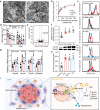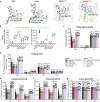Antioxidant hepatic lipid metabolism can be promoted by orally administered inorganic nanoparticles
- PMID: 37339977
- PMCID: PMC10281969
- DOI: 10.1038/s41467-023-39423-3
Antioxidant hepatic lipid metabolism can be promoted by orally administered inorganic nanoparticles
Abstract
Accumulation of inorganic nanoparticles in living organisms can cause an increase in cellular reactive oxygen species (ROS) in a dose-dependent manner. Low doses of nanoparticles have shown possibilities to induce moderate ROS increases and lead to adaptive responses of biological systems, but beneficial effects of such responses on metabolic health remain elusive. Here, we report that repeated oral administrations of various inorganic nanoparticles, including TiO2, Au, and NaYF4 nanoparticles at low doses, can promote lipid degradation and alleviate steatosis in the liver of male mice. We show that low-level uptake of nanoparticles evokes an unusual antioxidant response in hepatocytes by promoting Ces2h expression and consequently enhancing ester hydrolysis. This process can be implemented to treat specific hepatic metabolic disorders, such as fatty liver in both genetic and high-fat-diet obese mice without causing observed adverse effects. Our results demonstrate that low-dose nanoparticle administration may serve as a promising treatment for metabolic regulation.
© 2023. The Author(s).
Conflict of interest statement
The authors declare no competing interests.
Figures





Similar articles
-
Antioxidant properties of tea blunt ROS-dependent lipogenesis: beneficial effect on hepatic steatosis in a high fat-high sucrose diet NAFLD obese rat model.J Nutr Biochem. 2017 Feb;40:95-104. doi: 10.1016/j.jnutbio.2016.10.012. Epub 2016 Oct 29. J Nutr Biochem. 2017. PMID: 27866076
-
PSA controls hepatic lipid metabolism by regulating the NRF2 signaling pathway.J Mol Cell Biol. 2021 Oct 21;13(7):527-539. doi: 10.1093/jmcb/mjab033. J Mol Cell Biol. 2021. PMID: 34048566 Free PMC article.
-
Thrombospondin 1 improves hepatic steatosis in diet-induced insulin-resistant mice and is associated with hepatic fat content in humans.EBioMedicine. 2020 Jul;57:102849. doi: 10.1016/j.ebiom.2020.102849. Epub 2020 Jun 21. EBioMedicine. 2020. PMID: 32580141 Free PMC article.
-
Serine prevented high-fat diet-induced oxidative stress by activating AMPK and epigenetically modulating the expression of glutathione synthesis-related genes.Biochim Biophys Acta Mol Basis Dis. 2018 Feb;1864(2):488-498. doi: 10.1016/j.bbadis.2017.11.009. Epub 2017 Nov 17. Biochim Biophys Acta Mol Basis Dis. 2018. PMID: 29158183
-
Kupffer Cells Sense Free Fatty Acids and Regulate Hepatic Lipid Metabolism in High-Fat Diet and Inflammation.Cells. 2020 Oct 8;9(10):2258. doi: 10.3390/cells9102258. Cells. 2020. PMID: 33050035 Free PMC article.
Cited by
-
Rational Design of Safer Inorganic Nanoparticles via Mechanistic Modeling-Informed Machine Learning.ACS Nano. 2025 Jun 17;19(23):21538-21555. doi: 10.1021/acsnano.5c03590. Epub 2025 Jun 3. ACS Nano. 2025. PMID: 40460056 Free PMC article.
-
Phytic acid-based nanomedicine against mTOR represses lipogenesis and immune response for metabolic dysfunction-associated steatohepatitis therapy.Life Metab. 2024 Jun 18;3(6):loae026. doi: 10.1093/lifemeta/loae026. eCollection 2024 Dec. Life Metab. 2024. PMID: 39873005 Free PMC article.
-
Rational Design of Safer Inorganic Nanoparticles via Mechanistic Modeling-informed Machine Learning.Res Sq [Preprint]. 2025 Feb 18:rs.3.rs-5960303. doi: 10.21203/rs.3.rs-5960303/v1. Res Sq. 2025. Update in: ACS Nano. 2025 Jun 17;19(23):21538-21555. doi: 10.1021/acsnano.5c03590. PMID: 40034433 Free PMC article. Updated. Preprint.
-
Black phosphorus for bone regeneration: Mechanisms involved and influencing factors.Mater Today Bio. 2024 Aug 24;28:101211. doi: 10.1016/j.mtbio.2024.101211. eCollection 2024 Oct. Mater Today Bio. 2024. PMID: 39280114 Free PMC article. Review.
-
Effects of Crocus sativus L. Floral Bio-Residues Related to Skin Protection.Antioxidants (Basel). 2024 Mar 17;13(3):358. doi: 10.3390/antiox13030358. Antioxidants (Basel). 2024. PMID: 38539891 Free PMC article.
References
Publication types
MeSH terms
Substances
LinkOut - more resources
Full Text Sources
Medical

